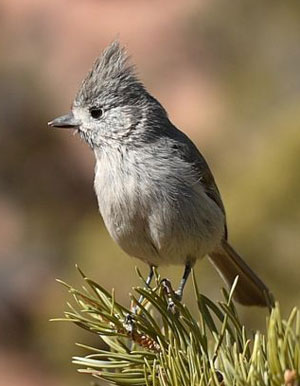Contents: Species, Interesting Facts, Identification, Distribution, Preferred Nesting Habitat, Diet, Nesting Behavior, Nestboxes, Nestbox Location, Recommended Distance Between Nestboxes, Monitoring, Nesting Timetable, Longevity, More Info. Also see Photos of Nests, Eggs and Young. Also see All About Titmice.
Species: Baeolophus ridgwayi. Used to be combined with Oak Titmouse as the Plain Titmouse (Parus inoratus)
Interesting Facts: Females may sit so tightly that they remain in the box even if is moved.

Identification: Data on Juniper Titmice is lacking (e.g., on diet), so often it is assumed to be similar to the Oak Titmouse.
Distribution: Parts of Oregon, Idaho, Wyoming, Colorado, New Mexico, Arizona, Texas, and Mexico. Doesn’t migrate (year round resident)
Preferred Nesting Habitat: Warm, dry habitats of open woodland with lots of large junipers or mixed piñon-juniper woodland, especially with dense canopy.
Diet: Seeds (including piñon nuts) and terrestrial invertebrates (spiders), common bird feeder visitor. (Plain Titmouse).
Nesting Behavior: Female may be reluctant to leave nest, may hiss like a snake if disturbed.
Nestboxes: Majority chose a natural tree hole (e.g., in a stump, knotholes), may also use a woodpecker-excavated cavity. May also nest in pipes attached to trees or fence posts or eaves of buildings, or occasionally in a hole in a riverbank, or in crevice of a twisted juniper tree.
Nestbox Location: For Plain Titmouse, nest sites up to 32-50 feet off the ground (Western Birds Nests, Colorado Breeding Atlas), 3-10 feet off ground common (The Birder’s Handbook), often in well-concealed locations.
Recommended distance between nestboxes: For Plain Titmouse in birdhouses, boxes were 43-90 yards apart (Western Birds Nests),
Monitoring: Tufted Titmouse is sensitive to monitoring, may abandon nest during building if disturbed, may hiss like a snake during monitoring and female may refuse to leave eggs.
- Excavation or nest site selection: Begins inspecting sites in Feb-March. The female probably picks the site. May partially excavate own nest from soft or rotten wood, or alter cavity.
- Nest construction: Starts building mid-March through April through May. Later nests may indicate a failed first attempt or second brood. Probably female does most of nest construction. Nest made of hair, grass, shredded bark, moss, rootlets, straw and maybe some “cotton.” Female often continues to add lining (e.g., fur and fluff) during incubation and brooding. Nests may be reused in subsequent years.
- Egg laying: 3-9 eggs, 6-7 common. One egg laid every one to two days. Female may cover eggs with feathers/fur during egg laying. Female may add feathers or leaves to nest during egg-laying.
- Incubation: by female, 14-16 days.
- Hatching: Young are altricial.
- Development: Nestlings are noisy when parents come to feed them. Female broods, both parents remove fecal sacs. Young beg aggressively and noisily.
- Fledging: 16-21 days after hatching. Young do not fly out of nest – they usually all leave at once and fall to the ground. Juveniles start foraging on day 5, by five weeks are independent.
- Dispersal: Broods break up about 1 month after fledging.
- Number of broods: Usually only one, second broods rarely if ever. A late nesting may indicate an earlier failed attempt.
- Longevity: ?
References and More Information:
- Juniper Titmouse – Photos of eggs, nests, young (Sialis.org)
- Birds of North America online
- Western Birds’ Nests, 1979
- The Birders Handbook, 1988
- Colorado Breeding Bird Atlas, Hugh E. Kingery editor, 1998
– Colorado Breeding Bird Atlas, Hugh E. Kingery editor, 1998
